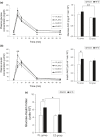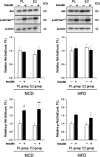Estradiol replacement improves high-fat diet-induced insulin resistance in ovariectomized rats
- PMID: 35238495
- PMCID: PMC8892597
- DOI: 10.14814/phy2.15193
Estradiol replacement improves high-fat diet-induced insulin resistance in ovariectomized rats
Abstract
The role of 17β-estradiol (E2) in high-fat diet (HFD)-induced alteration of the protein kinase B (Akt) signaling pathway in ovariectomized (OVX) rats is unclear. Therefore, we examined whether chronic estrogen replacement restores HFD-induced impairment in insulin sensitivity by its effects concomitant with alterations in the Akt isoform 2 (Akt2) and Akt substrate of 160 kDa (AS160) phosphorylation in muscles of OVX rats. Nine-week-old female Wistar rats underwent ovariectomy under anesthesia; after 4 weeks, subcutaneous implantation of either E2 or placebo (PL) pellets was performed, and HFD feeding was initiated. Intravenous glucose tolerance tests were performed to assess insulin sensitivity. Following insulin injection into rats' portal vein, the liver and gastrocnemius muscle were dissected for insulin signaling analysis. We observed that HFD increased energy intake and body weight in the PL group; however, it was temporarily decreased in the E2 group. Adipose tissue accumulation was larger in HFD-fed rats than in normal chow diet (NCD)-fed rats in the PL group; however, this difference was not observed in the E2 group. HFD reduced insulin sensitivity in the PL group only. In vivo insulin stimulation increased Akt2 phosphorylation in the muscles of NCD-fed rats in both groups. In contrast, HFD affected insulin-stimulated phosphorylation of Akt2 and AS160 in the muscles of rats in the PL group but not in the E2 group. Our data suggest that E2 replacement improves HFD-induced insulin resistance, and this effect is accompanied by the alterations in the Akt2 and AS160 phosphorylation in insulin-stimulated muscles of OVX rats.
Keywords: AS160; Akt2; estradiol replacement; high-fat diet; insulin resistance; ovariectomized rat.
© 2022 The Authors. Physiological Reports published by Wiley Periodicals LLC on behalf of The Physiological Society and the American Physiological Society.
Conflict of interest statement
The authors declare that the research was conducted in the absence of any commercial or financial relationships that could be construed as a potential conflict of interest.
Figures




Similar articles
-
Estrogen replacement enhances insulin-induced AS160 activation and improves insulin sensitivity in ovariectomized rats.Am J Physiol Endocrinol Metab. 2018 Dec 1;315(6):E1296-E1304. doi: 10.1152/ajpendo.00131.2018. Epub 2018 Sep 4. Am J Physiol Endocrinol Metab. 2018. PMID: 30179516
-
Estradiol Replacement Improves High-Fat Diet-Induced Obesity by Suppressing the Action of Ghrelin in Ovariectomized Rats.Nutrients. 2020 Mar 26;12(4):907. doi: 10.3390/nu12040907. Nutrients. 2020. PMID: 32224927 Free PMC article.
-
Exercise effects on γ3-AMPK activity, phosphorylation of Akt2 and AS160, and insulin-stimulated glucose uptake in insulin-resistant rat skeletal muscle.J Appl Physiol (1985). 2020 Feb 1;128(2):410-421. doi: 10.1152/japplphysiol.00428.2019. Epub 2020 Jan 16. J Appl Physiol (1985). 2020. PMID: 31944891 Free PMC article.
-
Exercise effects on γ3-AMPK activity, Akt substrate of 160 kDa phosphorylation, and glucose uptake in muscle of normal and insulin-resistant female rats.J Appl Physiol (1985). 2022 Jan 1;132(1):140-153. doi: 10.1152/japplphysiol.00533.2021. Epub 2021 Dec 9. J Appl Physiol (1985). 2022. PMID: 34882030 Free PMC article.
-
Cellular mechanism by which estradiol protects female ovariectomized mice from high-fat diet-induced hepatic and muscle insulin resistance.Endocrinology. 2013 Mar;154(3):1021-8. doi: 10.1210/en.2012-1989. Epub 2013 Jan 30. Endocrinology. 2013. PMID: 23364948 Free PMC article.
Cited by
-
Insight into genetic, biological, and environmental determinants of sexual-dimorphism in type 2 diabetes and glucose-related traits.Front Cardiovasc Med. 2022 Nov 24;9:964743. doi: 10.3389/fcvm.2022.964743. eCollection 2022. Front Cardiovasc Med. 2022. PMID: 36505380 Free PMC article. Review.
-
Deciphering the role of classical oestrogen receptor in insulin resistance and type 2 diabetes mellitus: From molecular mechanism to clinical evidence.Bioimpacts. 2024 Aug 4;15:30378. doi: 10.34172/bi.30378. eCollection 2025. Bioimpacts. 2024. PMID: 40256228 Free PMC article. Review.
-
Lycopene Improves Metabolic Disorders and Liver Injury Induced by a Hight-Fat Diet in Obese Rats.Molecules. 2022 Nov 10;27(22):7736. doi: 10.3390/molecules27227736. Molecules. 2022. PMID: 36431836 Free PMC article.
References
-
- Alessi, D. R. , & Downes, C. P. (1998). The role of PI 3‐kinase in insulin action. Biochimica Et Biophysica Acta, 1436, 151–164. - PubMed
-
- Badin, P. M. , Vila, I. K. , Louche, K. , Mairal, A. , Marques, M. A. , Bourlier, V. , Tavernier, G. , Langin, D. , & Moro, C. (2013). High‐fat diet‐mediated lipotoxicity and insulin resistance is related to impaired lipase expression in mouse skeletal muscle. Endocrinology, 154, 1444–1453. - PubMed
-
- Baum, J. I. , O'Connor, J. C. , Seyler, J. E. , Anthony, T. G. , Freund, G. G. , & Layman, D. K. (2005). Leucine reduces the duration of insulin‐induced PI 3‐kinase activity in rat skeletal muscle. American Journal of Physiology: Endocrinology and Metabolism, 288, E86–E91. - PubMed
-
- Boozer, C. N. , Schoenbach, G. , & Atkinson, R. L. (1995). Dietary fat and adiposity: A dose‐response relationship in adult male rats fed isocalorically. American Journal of Physiology: Endocrinology and Metabolism, 268, E546–E550. - PubMed
Publication types
MeSH terms
Substances
LinkOut - more resources
Full Text Sources
Miscellaneous

